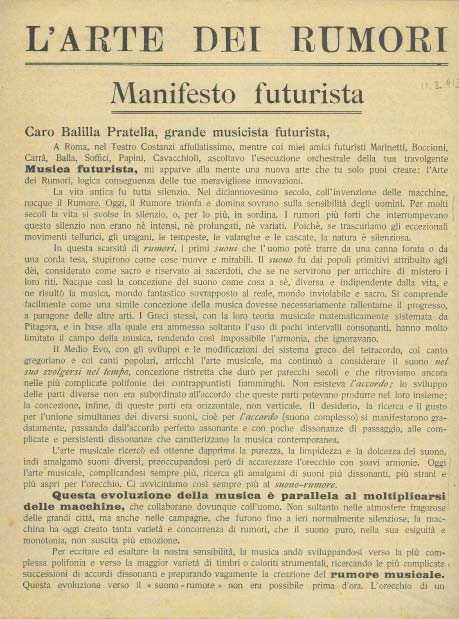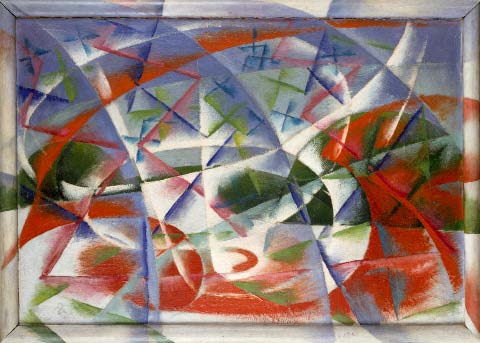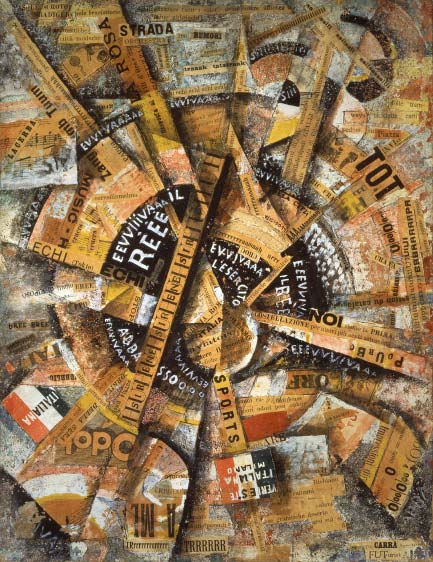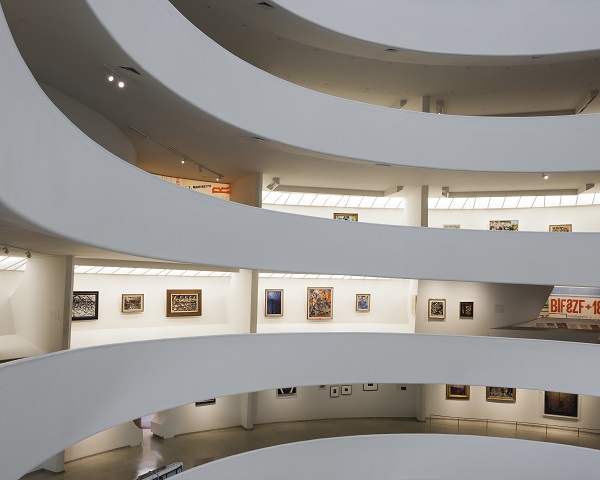![Giacomo Balla The Hand of the Violinist (The Rhythms of the Bow) (La mano del violinista [I ritmi dell’archetto]), 1912 Oil on canvas, 56 x 78.3 cm Estorick Collection, London © 2014 Artists Rights Society (ARS), New York / SIAE, Rome](https://lideamagazine.com//wp-content/uploads/2014/07/futurism_balla-300x215.jpg)
The Hand of the Violinist (The Rhythms of the Bow) (La mano del violinista
[I ritmi dell’archetto]), 1912
Oil on canvas, 56 x 78.3 cm
Estorick Collection, London
© 2014 Artists Rights Society (ARS), New York / SIAE, Rome
The exhibition is organized by Vivien Greene, Senior Curator, 19th- and Early 20th-Century Art, Solomon R. Guggenheim Museum. An international advisory committee composed of eminent scholars from many disciplines provided expertise and guidance in the preparation of this thorough exploration of the Futurist movement, a major modernist expression that in many ways remains little
known among American audiences.
This exhibition is made possible by Lavazza.
Support is provided in part by the National Endowment for the Arts and the David Berg Foundation, with additional funding from the Juliet Lea Hillman Simonds Foundation, The Robert Lehman Foundation, and the New York State Council on the Arts.
The Leadership Committee for Italian Futurism, 1909–1944: Reconstructing the Universe is also gratefully acknowledged for its generosity, including the Hansjörg Wyss Charitable Endowment; Stefano and Carole Acunto; Giancarla and Luciano Berti; Ginevra Caltagirone; Massimo and Sonia Cirulli Archive; Daniela Memmo d’Amelio; Achim Moeller, Moeller Fine Art; Pellegrini Legacy
Trust; and Alberto and Gioietta Vitale.
This exhibition is supported by an indemnity from the Federal Council on the Arts and the Humanities.
About Futurism

“The Art of Noises: Futurist Manifesto” (“L’arte dei rumori: Manifesto
futurista”)
Leaflet (Milan: Direzione del Movimento Futurista, 1913), 29.2 x 23 cm
Wolfsoniana – Fondazione regionale per la Cultura e lo Spettacolo, Genoa
By permission of heirs of the artist
Photo: Courtesy Wolfsoniana – Fondazione regionale per la Cultura e lo
Spettacolo, Genoa
Futurism was launched in 1909 against a background of growing economic and social upheaval. In Marinetti’s “The Founding and Manifesto of Futurism,” published in Le Figaro, he outlined the movement’s key aims, among them: to abolish the past, to champion modernization, and to extol aggression. Although it began as a literary movement, Futurism soon embraced the visual arts as well as
advertising, fashion, music and theater, and it spread throughout Italy and beyond. The Futurists rejected stasis and tradition and drew inspiration from the emerging industry, machinery, and speed of the modern metropolis. The first generation of artists created works characterized by dynamic movement and fractured forms, aspiring to break with existing notions of space and time to place the viewer at the center of the artwork. Extending into many mediums, Futurism was intended to be not just an artistic idiom but an entirely new way of life. Central to the movement was the concept of the opera d’arte totale or “total work of art,” in which the viewer is surrounded by a completely Futurist environment.
More than two thousand individuals were associated with the movement over its duration. In addition to Marinetti, central figures include: artists Giacomo Balla, Benedetta (Benedetta Cappa Marinetti), Umberto Boccioni, Carlo Carrà, Fortunato Depero, and Enrico Prampolini; poets and writers Francesco Cangiullo and Rosa Rosà; architect Antonio Sant’Elia; composer Luigi Russolo; photographers Anton Giulio Bragaglia and Tato (Guglielmo Sansoni); dancer Giannina Censi; and ceramicist Tullio d’Albisola. These figures and other lesser-known ones are represented in the exhibition. Futurism is commonly understood to have had two phases: “heroic” Futurism, which lasted until around 1916, and a later incarnation that arose after World War I and remained active until the early 1940s. Investigations of “heroic” Futurism have predominated and comparatively few exhibitions have explored
the subsequent life of the movement; until now, a comprehensive overview of Italian Futurism had yet to be presented in the U.S. Italian art of the 1920s and ’30s is little known outside of its home country, due in part to a taint from Futurism’s sometime association with Fascism. This association complicates the narrative of this avant-garde and makes it all the more necessary to delve into and clarify its full history.

Abstract Speed + Sound (Velocità astratta + rumore), 1913–14
Oil on unvarnished millboard in artist’s painted frame, 54.5 x 76.5 cm
The Solomon R. Guggenheim Foundation, Peggy Guggenheim
Collection, Venice 76.2553.31
© 2014 Artists Rights Society (ARS), New York / SIAE, Rome
Photo: Courtesy Solomon R. Guggenheim Foundation, New York
Exhibition Overview
Italian Futurism unfolds chronologically, juxtaposing works in different mediums as it traces the myriad artistic languages the Futurists employed as their practice evolved over a 35-year period. The exhibition begins with an exploration of the manifesto as an art form, and proceeds to the Futurists’ catalytic encounter with Cubism in 1911, their exploration of near-abstract compositions, and their early efforts in photography. Ascending the rotunda levels of the museum, visitors follow the movement’s progression as it expanded to include architecture, clothing, design, dinnerware, experimental poetry, and toys.
Along the way, it gained new practitioners and underwent several stylistic evolutions—shifting from the fractured spaces of the 1910s to the machine aesthetics (or arte meccanica) of the ’20s, and then to the softer, lyrical forms of the ’30s. Aviation’s popularity and nationalist significance in 1930s Italy led to the swirling, often abstracted, aerial imagery of Futurism’s final incarnation, aeropittura. This novel painting approach united the Futurist interest in nationalism, speed, technology, and war with new and dizzying visual perspectives. The fascination with the aerial spread to other mediums, including ceramics, dance,
and experimental aerial photography.

Interventionist Demonstration (Manifestazione Interventista), 1914
Tempera, pen, mica powder, paper glued on cardboard, 38.5 x 30 cm
Gianni Mattioli Collection, on long-term loan to the Peggy Guggenheim
Collection, Venice
© 2014 Artists Rights Society (ARS), New York / SIAE, Rome
Photo: Courtesy Solomon R. Guggenheim Foundation, New York
The exhibition is enlivened by three films commissioned from documentary filmmaker Jen Sachs, which use archival film footage, documentary photographs, printed matter, writings, recorded declamations, and musical compositions to represent the Futurists’ more ephemeral work and to bring to life their words-in-freedom poems. One film addresses the Futurists’ evening performances and events, called serate, which merged “high” and “low” culture in radical ways and broke down barriers between spectator and performer. Mise-en-scène installations evoke the Futurists’ opera d’arte totale interior ensembles, from those executed for the private sphere to those realized under Fascism.
Italian Futurism concludes with the five monumental canvases that compose the Syntheses of Communications (1933–34) by Benedetta(Benedetta Cappa Marinetti), which are being shown for the first time outside of their original location. One of few public commissions awarded to a Futurist in the 1930s, the series of paintings was created for the Palazzo delle Poste (Post Office) in Palermo, Sicily.
The paintings celebrate multiple modes of communication, many enabled by technological innovations, and correspond with the themes of modernity and the “total work of art” concept that underpinned the Futurist ethos.

Elasticity (Elasticità), 1912
Oil on canvas, 100 x 100 cm
Museo del Novecento, Milan
© Museo del Novecento, Comune di Milano (all legal rights reserved)
Photo: Luca Carrà







